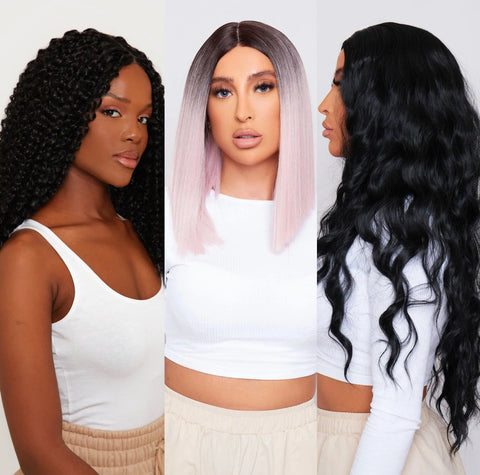Choosing the right hair is essential in a world where personal style is celebrated. Synthetic hair wigs have become an increasingly popular choice, offering versatility and affordability without compromising on style.
One significant advantage of synthetic hair wigs is that they do not require extensive styling or regular visits to the salon. This saves you valuable time and effort, especially for those with a busy lifestyle.
Another advantage of synthetic hair wigs is their durability. Unlike human hair, synthetic hair wigs are less prone to fading or losing their shape due to these factors.
Synthetic hair wigs are an appealing choice for anyone looking for a low-maintenance, durable, and affordable option that can be easily customized to suit their personal style.
Types of Synthetic Hair Wigs
Synthetic hair wigs come in various types, each offering unique features and benefits. Understanding the different types can help you choose the right synthetic wig that suits your needs and preferences.
- Traditional Synthetic Wigs: Traditional synthetic wigs are the most common type of synthetic hair wigs. They are made from synthetic fibers that mimic the appearance and texture of natural hair. These wigs often come in a wide range of colors, styles, and lengths, allowing individuals to find the perfect match for their desired look. Traditional synthetic wigs are pre-styled and require minimal maintenance, making them a popular choice for everyday wear.
- Heat-Friendly Synthetic Wigs: Heat-friendly synthetic wigs offer the flexibility of styling with heat tools such as curling irons and straighteners. These wigs are made from heat-resistant synthetic fibers that can withstand temperatures up to a certain degree. Heat-friendly synthetic wigs provide individuals with the ability to change their hairstyle and try different looks without damaging the fibers.
- Monofilament Synthetic Wigs: Monofilament synthetic wigs have a monofilament cap construction, which means that each hair strand is individually hand-tied to the cap. This creates a natural-looking scalp and allows for multidirectional parting. Monofilament synthetic wigs are incredibly comfortable to wear and provide a realistic appearance, making them an excellent choice for individuals with sensitive scalps or those experiencing hair loss.
Choosing the right type of synthetic hair wig depends on your desired style, comfort level, and budget. Consider your preferences and needs to find the perfect synthetic wig that enhances your personal style.
How to Choose the Right Synthetic Hair Wig
Choosing the right synthetic hair wig can be an exciting process. With numerous options available, it's essential to consider several factors to ensure you select a wig that suits your needs and preferences.
- Style and Length: Determine the style and length of the wig that aligns with your desired look. Synthetic hair wigs come in various styles, including straight, wavy, and curly, allowing you to choose a wig that complements your natural hair or offers a completely new style. Consider the length of the wig as well, whether you prefer short, medium, or long hair.
- Color: Synthetic hair wigs are available in an extensive range of colors and shades. Consider your skin tone, eye color, and personal style when selecting the color of your wig. You can choose a color that matches your natural hair or opt for a bold and vibrant shade to make a statement.
- Cap Construction: Pay attention to the cap construction of the synthetic wig. Different cap constructions offer varying levels of comfort and realism. Consider features such as lace front, monofilament, or hand-tied caps to enhance the natural appearance and comfort of the wig.
- Budget: Set a budget for your synthetic hair wig purchase. Synthetic wigs come in a wide price range, so determining your budget beforehand will help narrow down your options. Remember that higher-priced wigs may offer additional features or higher-quality materials.
By considering these factors, you can choose a synthetic hair wig that not only enhances your style but also provides you with comfort and confidence.
Synthetic Hair Wig Care and Maintenance
- Washing: Follow the manufacturer's instructions for washing your synthetic wig. Typically, it's recommended to use a wig shampoo specifically formulated for synthetic fibers. Gently lather the shampoo into the wig, focusing on the hair strands, and rinse thoroughly with cool water. Avoid rubbing or twisting the wig during washing.
- Drying: After washing, gently blot the wig with a towel to remove excess water. Avoid wringing or twisting the wig, as this can cause damage to the synthetic fibers. Place the wig on a wig stand or mannequin head to air dry naturally. Avoid exposing the wig to direct sunlight or heat sources during the drying process.
- Styling Products: Use styling products specifically designed for synthetic hair wigs. Avoid using regular hair products, as they may contain ingredients that can damage the synthetic fibers. Apply a small amount of wig conditioner or detangler to the wig to keep it soft and manageable.
- Brushing and Detangling: Use a wide-toothed comb or a wig brush specifically designed for synthetic hair wigs to gently brush and detangle the hair. Start from the ends and work your way up to prevent excessive pulling or tugging. Avoid using regular brushes or combs, as they can cause static and damage to the synthetic fibers.
- Storage: When not in use, store your synthetic wig on a wig stand or in a breathable bag to maintain its shape and prevent tangling. Avoid storing the wig in a tightly sealed container or in direct sunlight, as this can cause damage to the fibers.



